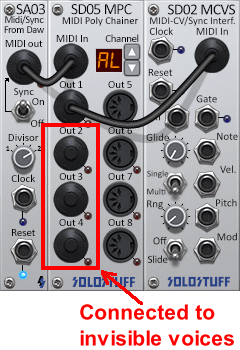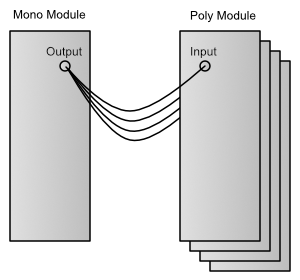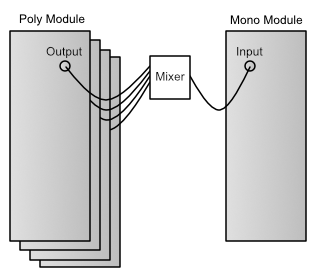Polyphony in SoloRack
Note: This tutorial describes the new automatic polyphony system in SoloRack v2 and above. The old manual polyphony system still works too.
You can convert most mono patches to poly patches using the following steps. Simply choose the number of voices you want in the Polyphony menu. (SoloRack will automatically add the SD05 MIDI Poly Chainer if it didn’t exist in your patch). Then connect the SD05 between the SA03 and the SD02 as illustrated:

Thats it!!. SoloRack will automatically create invisible duplicate voices and connect them to the SD05. You can play your patch polyphonically now. Polyphony in modular just doesn’t get simpler than this. Note here, more voices obviously will consume more CPU*.
Per Module Polyphony
You can force a module to work in mono even though you’ve chosen polyphony. When you right click a module, there is a menu item called Mono. This specifies whether or not the module works in poly or mono. Typically, not all modules need to work in poly to achieve proper polyphony. By default, the following rules apply:
1. All mixers, envelope generators, filters, oscillators and sound sources work in poly mode by default. Except for the S318 Tracker Mod Player, the S313 Internet Radio, and the S303 Noise. These 3 modules work in mono by default.
2. All other modules in SoloRack work in mono by default. Except for the SD02 MIDI-CV/Sync. Which works in poly by default.
These defaults have been chosen to facilitate good CPU usage within most common usage of subtractive patching. We expect that you wouldn’t need to change them 80% of the time. But sometimes oddities may occur where you need to change these settings per module. For example, distortion modules may or may not need to be put in poly mode sometimes because these are level sensitive. Playing polyphonically into a mono distortion module will lead to more distortion being applied which may not be what you want. Another example is when using switch modules like the S806 or the S810. These can be used to switch CV or audio. When used with audio, you most probably want to make them poly.
What happens when a module is working in poly?
Think of a poly module as MULTIPLE copies of the module working identically for each voice behind the scene.
What happens when you connect a mono module output to a poly module input ?
When you do this, the output signal is split to all copies of the poly module. As if you’ve taken multiple cables from the output and connected them to the input of the poly module PER VOICE. As illustrated:

What happens when you connect a poly module output to a mono module input ?
In this case, The outputs per voice are mixed and sent to the mono module input. It’s as if you’ve put a mixer in between. As illustrated:

This mixer thing will only be done for audio/CV cables. MIDI cables can’t be mixed, so what happens with MIDI cables is that only the FIRST voice of the poly module will be sent to the mono module, all other voices are ignored.
All these shenanigans are done invisibly and automatically. All you do is just connect the two modules together with a single cable. It is needless to say here that when you choose only 1 voice in the Polyphony menu, both poly and mono modules will work in mono.
When things go wrong
If the above is misused it can produce undesirable results. For example if you connect an audio mono module to an audio effect poly module then connect that poly module output to another audio effect mono module the result will be amplification of the audio. Unless you know what you’r doing, this has no use other than wasting CPU and hurting your ears!!
*Although the SD05 has 8 MIDI out ports. It actually supports 16 voices polyphony when used with the automatic system.
